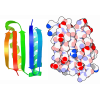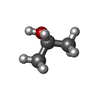+ Open data
Open data
- Basic information
Basic information
| Entry | Database: PDB / ID: 7yvv | ||||||
|---|---|---|---|---|---|---|---|
| Title | AcmP1, R-4-hydroxymandelate synthase | ||||||
 Components Components | 4-hydroxyphenylpyruvate dioxygenase | ||||||
 Keywords Keywords |  BIOSYNTHETIC PROTEIN / Fe (II)-dependent dioxygenase / R-Enantioselectivity BIOSYNTHETIC PROTEIN / Fe (II)-dependent dioxygenase / R-Enantioselectivity | ||||||
| Function / homology |  Function and homology information Function and homology informationaromatic amino acid metabolic process /  4-hydroxyphenylpyruvate dioxygenase / 4-hydroxyphenylpyruvate dioxygenase /  4-hydroxyphenylpyruvate dioxygenase activity / 4-hydroxyphenylpyruvate dioxygenase activity /  metal ion binding metal ion bindingSimilarity search - Function | ||||||
| Biological species |  Amycolatopsis sp. Hca4 (bacteria) Amycolatopsis sp. Hca4 (bacteria) | ||||||
| Method |  X-RAY DIFFRACTION / X-RAY DIFFRACTION /  SYNCHROTRON / SYNCHROTRON /  MOLECULAR REPLACEMENT / Resolution: 2.1 Å MOLECULAR REPLACEMENT / Resolution: 2.1 Å | ||||||
 Authors Authors | Zhang, B. / Ge, H.M. | ||||||
| Funding support |  China, 1items China, 1items
| ||||||
 Citation Citation |  Journal: To Be Published Journal: To Be PublishedTitle: Characterization of AcmP1 as the native R-4-hydroxymandelate synthase from biosynthetic pathway of Amycolamycins Authors: Zhang, B. / Ge, H.M. | ||||||
| History |
|
- Structure visualization
Structure visualization
| Structure viewer | Molecule:  Molmil Molmil Jmol/JSmol Jmol/JSmol |
|---|
- Downloads & links
Downloads & links
- Download
Download
| PDBx/mmCIF format |  7yvv.cif.gz 7yvv.cif.gz | 148 KB | Display |  PDBx/mmCIF format PDBx/mmCIF format |
|---|---|---|---|---|
| PDB format |  pdb7yvv.ent.gz pdb7yvv.ent.gz | 112.9 KB | Display |  PDB format PDB format |
| PDBx/mmJSON format |  7yvv.json.gz 7yvv.json.gz | Tree view |  PDBx/mmJSON format PDBx/mmJSON format | |
| Others |  Other downloads Other downloads |
-Validation report
| Arichive directory |  https://data.pdbj.org/pub/pdb/validation_reports/yv/7yvv https://data.pdbj.org/pub/pdb/validation_reports/yv/7yvv ftp://data.pdbj.org/pub/pdb/validation_reports/yv/7yvv ftp://data.pdbj.org/pub/pdb/validation_reports/yv/7yvv | HTTPS FTP |
|---|
-Related structure data
| Related structure data |  2r5vS S: Starting model for refinement |
|---|---|
| Similar structure data | Similarity search - Function & homology  F&H Search F&H Search |
- Links
Links
- Assembly
Assembly
| Deposited unit | 
| ||||||||
|---|---|---|---|---|---|---|---|---|---|
| 1 |
| ||||||||
| Unit cell |
|
- Components
Components
| #1: Protein |  / AcmP1 / R-4-hydroxymandelate synthase / AcmP1 / R-4-hydroxymandelate synthaseMass: 40268.621 Da / Num. of mol.: 1 Source method: isolated from a genetically manipulated source Source: (gene. exp.)  Amycolatopsis sp. Hca4 (bacteria) / Gene: hppD, HUT10_16010 Amycolatopsis sp. Hca4 (bacteria) / Gene: hppD, HUT10_16010Production host:   Escherichia coli 'BL21-Gold(DE3)pLysS AG' (bacteria) Escherichia coli 'BL21-Gold(DE3)pLysS AG' (bacteria)References: UniProt: A0A7H8HIR4,  4-hydroxyphenylpyruvate dioxygenase 4-hydroxyphenylpyruvate dioxygenase | ||||||||
|---|---|---|---|---|---|---|---|---|---|
| #2: Chemical |  Isopropyl alcohol Isopropyl alcohol#3: Chemical | ChemComp-FE / |  Iron Iron#4: Chemical |  Chloride Chloride#5: Water | ChemComp-HOH / |  Water WaterHas ligand of interest | Y | |
-Experimental details
-Experiment
| Experiment | Method:  X-RAY DIFFRACTION / Number of used crystals: 1 X-RAY DIFFRACTION / Number of used crystals: 1 |
|---|
- Sample preparation
Sample preparation
| Crystal | Density Matthews: 2.04 Å3/Da / Density % sol: 39.74 % |
|---|---|
Crystal grow | Temperature: 295.15 K / Method: vapor diffusion, sitting drop Details: 0.1 M HEPES sodium pH 7.5, 10% v/v 2-Propanol, 20% w/v Polyethylene glycol 4,000 |
-Data collection
| Diffraction | Mean temperature: 77.15 K / Serial crystal experiment: N | ||||||||||||||||||||||||||||||
|---|---|---|---|---|---|---|---|---|---|---|---|---|---|---|---|---|---|---|---|---|---|---|---|---|---|---|---|---|---|---|---|
| Diffraction source | Source:  SYNCHROTRON / Site: SYNCHROTRON / Site:  SSRF SSRF  / Beamline: BL19U1 / Wavelength: 0.97853 Å / Beamline: BL19U1 / Wavelength: 0.97853 Å | ||||||||||||||||||||||||||||||
| Detector | Type: DECTRIS PILATUS 6M / Detector: PIXEL / Date: Dec 22, 2017 | ||||||||||||||||||||||||||||||
| Radiation | Protocol: SINGLE WAVELENGTH / Monochromatic (M) / Laue (L): M / Scattering type: x-ray | ||||||||||||||||||||||||||||||
| Radiation wavelength | Wavelength : 0.97853 Å / Relative weight: 1 : 0.97853 Å / Relative weight: 1 | ||||||||||||||||||||||||||||||
| Reflection twin | Operator: h,-h-k,-l / Fraction: 0.33 | ||||||||||||||||||||||||||||||
| Reflection | Resolution: 2.1→61.6 Å / Num. obs: 18285 / % possible obs: 98.3 % / Redundancy: 4.7 % / CC1/2: 0.985 / Rmerge(I) obs: 0.171 / Rpim(I) all: 0.087 / Rrim(I) all: 0.192 / Net I/σ(I): 6.9 / Num. measured all: 85544 / Scaling rejects: 7 | ||||||||||||||||||||||||||||||
| Reflection shell | Diffraction-ID: 1
|
- Processing
Processing
| Software |
| ||||||||||||||||||||||||||||||||||||||||||||||||||||||||||||||||||||||||||||||||||||||||||||||||||
|---|---|---|---|---|---|---|---|---|---|---|---|---|---|---|---|---|---|---|---|---|---|---|---|---|---|---|---|---|---|---|---|---|---|---|---|---|---|---|---|---|---|---|---|---|---|---|---|---|---|---|---|---|---|---|---|---|---|---|---|---|---|---|---|---|---|---|---|---|---|---|---|---|---|---|---|---|---|---|---|---|---|---|---|---|---|---|---|---|---|---|---|---|---|---|---|---|---|---|---|
| Refinement | Method to determine structure : :  MOLECULAR REPLACEMENT MOLECULAR REPLACEMENTStarting model: 2R5V Resolution: 2.1→61.6 Å / Cross valid method: THROUGHOUT / σ(F): 84.32 / Phase error: 27.38 / Stereochemistry target values: TWIN_LSQ_F
| ||||||||||||||||||||||||||||||||||||||||||||||||||||||||||||||||||||||||||||||||||||||||||||||||||
| Solvent computation | Shrinkage radii: 0.9 Å / VDW probe radii: 1.11 Å / Solvent model: FLAT BULK SOLVENT MODEL | ||||||||||||||||||||||||||||||||||||||||||||||||||||||||||||||||||||||||||||||||||||||||||||||||||
| Displacement parameters | Biso max: 92.28 Å2 / Biso mean: 25.5535 Å2 / Biso min: 4.86 Å2 | ||||||||||||||||||||||||||||||||||||||||||||||||||||||||||||||||||||||||||||||||||||||||||||||||||
| Refinement step | Cycle: final / Resolution: 2.1→61.6 Å
| ||||||||||||||||||||||||||||||||||||||||||||||||||||||||||||||||||||||||||||||||||||||||||||||||||
| LS refinement shell | Refine-ID: X-RAY DIFFRACTION / Rfactor Rfree error: 0 / Total num. of bins used: 13
| ||||||||||||||||||||||||||||||||||||||||||||||||||||||||||||||||||||||||||||||||||||||||||||||||||
| Refinement TLS params. | Method: refined / Origin x: 10.019 Å / Origin y: 20.4105 Å / Origin z: 0.9351 Å
| ||||||||||||||||||||||||||||||||||||||||||||||||||||||||||||||||||||||||||||||||||||||||||||||||||
| Refinement TLS group |
|
 Movie
Movie Controller
Controller



 PDBj
PDBj







